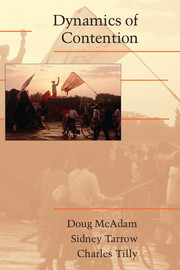Book contents
4 - MOBILIZATION IN COMPARATIVE PERSPECTIVE
Published online by Cambridge University Press: 05 June 2012
Summary
Where do we stand now? Chapter 2 identified difficulties in standard analyses of contentious origins. Chapter 3 then proposed remedies for those difficulties in the identification of widely applicable causal mechanisms and their compounding into recurrent processes of mobilization and demobilization, actors, and trajectories. In this chapter, we begin to show the applicability of that approach to the wide range of episodes included in Table 3.1 and Figure 3.1. We are not testing some general theory concerning the origins of contention. Instead, we seek to identify important mechanisms that play significant causal parts in a wide variety of mobilization and demobilization.
We highlight the Mau Mau revolt in Kenya in the 1950s and the Yellow revolution of the Philippines in the 1980s to raise important questions about mobilization – the process we first featured in Chapter 2. The episodes differed enormously from each other: Mau Mau featured high levels of violence; the movement in the Philippines was largely nonviolent. Mau Mau involved almost no formal organization; the Philippine Yellow Revolution depended on a rich array of established and emergent national organizations and institutions. Though long viewed as an anticolonial revolt, Mau Mau was simultaneously something of an internal Kikuyu civil war. Events in the Philippines were neither anticolonial revolt nor civil war, but came closer to a broad social-democratic movement uniting most of Manilan, if not Filipino society.
- Type
- Chapter
- Information
- Dynamics of Contention , pp. 91 - 123Publisher: Cambridge University PressPrint publication year: 2001



